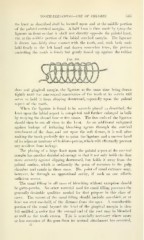Page 547 - My FlipBook
P. 547
TOOTH-BLEACHING— USE OF CHLORIN. 645
the knot as described shall be located upon and at the middle portion
of the palatal cervical margin. A half knot is then made by tying the
ligature in front so that it shall rest directly opposite the palatal knot,
viz. at the middle portion of the labial cervical margin. The ligature
is drawn into fairly close contact with the tooth, and, with both ends
held hrmly in the left hand and drawn somewhat tense, the portion
encircling the tooth is firmly but gently forced up against the rubber
Fig. 480.
dam and gingival margin, the ligature at the same time being drawn
tightly until the anatomical constriction of the tooth at its cervix will
serve to hold it from slipping downward, especially upon the palatal
aspect of the tooth.
When the ligature is found to be securely placed as described, the
knot upon the labial aspect is completed and further enlarged in bulk
by re-tying the thread four or five times. The free ends of the ligature
should then be cut oif close to the knot. As an additional safeguard
against leakage of irritating bleaching agents through the cervical
attachment of the dam, and out upon the soft tissues, it is well after
making the tooth perfectly dry to paint the ligature and a narrow band
of its adjacent territory with chloro-percha, which will effectually prevent
any accident from leakage.
The placing of a large knot upon the palatal aspect at the cervical
margin has another decided advantage in that it not only holds the dam
more securely against slipping downward, but holds it away from the
palatal surface, which is ordinarily the point of entrance to the pulp
chamber and canals in these cases. The point of canal entrance may,
however, be through an approximal cavity, if such an one affords
sufficient access.
The canal filling in all cases of bleaching without exception should
be gutta-percha. No other material used for canal filling possesses the
generally desirable qualities needed for that purpose in this class of
cases. The extent of the canal filling should include one-third, or at
least not over one-half, of the distance from the apex. A considerable
portion of the canal beyond the level of the gingival margin is thus
left unfilled in order that the coronal end of the root may be bleached
as well as the tooth crown. This is especially necessary where more
or less recession of the gum from its normal attachment has occurred,
35


